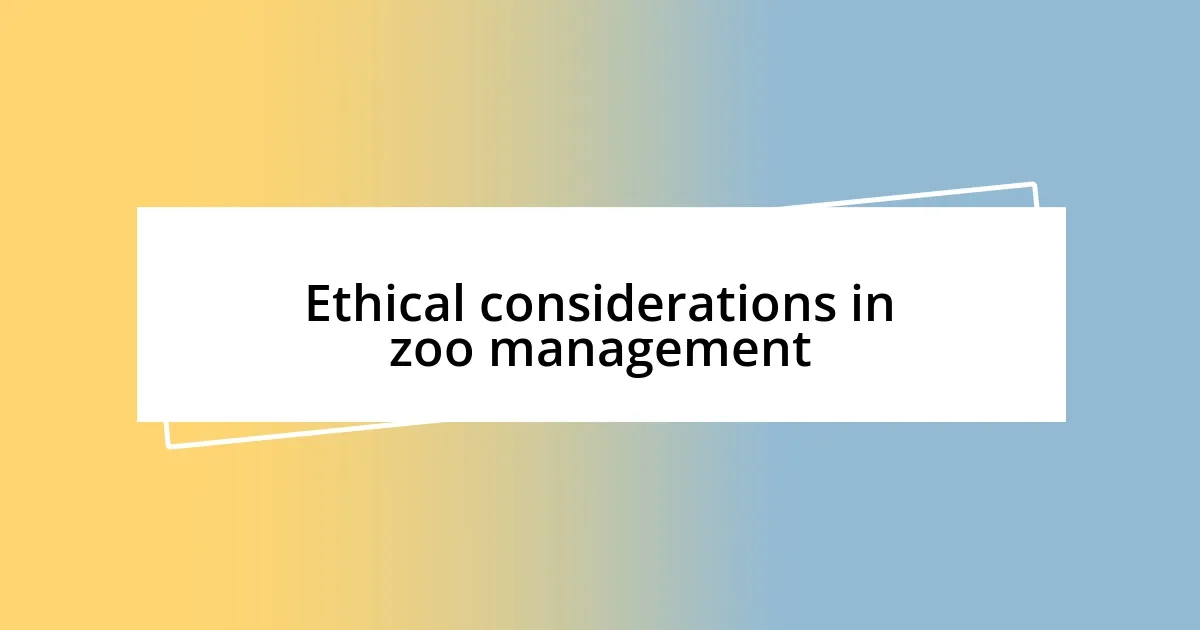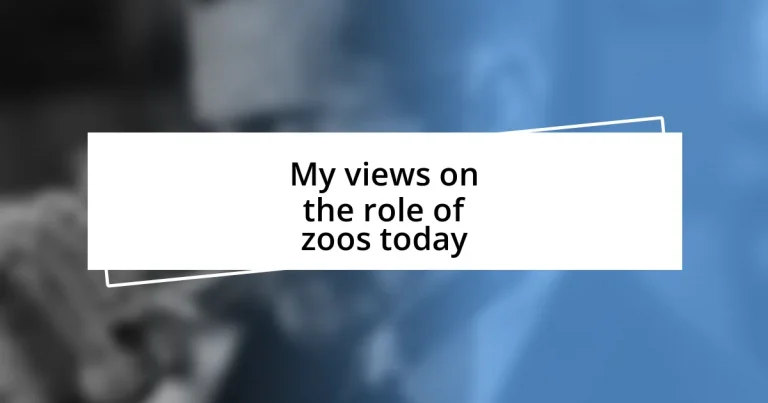Key takeaways:
- Zoos play a critical role in wildlife conservation through breeding programs for endangered species and rewilding initiatives, alongside educational outreach efforts.
- Historically, zoos have evolved from status symbols to institutions focused on animal welfare, research, and public education.
- Ethical considerations in zoo management emphasize the importance of animal welfare, transparency, and sustainable practices.
- Future trends include the integration of technology in education, conservation-focused exhibits, and collaborations with global conservation organizations.

Understanding the purpose of zoos
Zoos serve multiple purposes that extend beyond mere entertainment. Personally, I remember visiting a zoo as a child, marveling at the exotic animals and feeling a sense of wonder about the natural world. That experience ignited a curiosity in me, reminding me how zoos can provide educational opportunities that foster a deeper understanding of wildlife and conservation.
Another critical role of zoos is wildlife conservation. I’ve seen firsthand how zoos participate in breeding programs for endangered species, playing a vital part in attempts to revive populations that are dwindling in the wild. Isn’t it fascinating to think that a well-executed plan from a zoo could help save an entire species from extinction? This connection between education and conservation emphasizes the importance of supporting these institutions.
Moreover, zoos act as research hubs that contribute valuable insights into animal behavior and health. I’ve often wondered how much we truly understand about the nature of these creatures. The findings from zoo research can lead to better practices in the wild, which is a significant step toward creating a harmonious coexistence between humans and wildlife. The purpose of zoos, in my view, is not just to showcase animals but to act as custodians of knowledge and advocates for our planet’s biodiversity.

Historical perspective on zoos
Historically, zoos originated from menageries that displayed exotic animals, often owned by royalty or wealthy individuals. I think it’s fascinating to realize that these early versions of zoos were less about conservation and more about status symbols. I’ve always felt a genuine connection to the idea that people long ago were captivated by the beauty and mystery of animals, just like I was during my childhood zoo visits.
- The first modern zoo, the Vienna Zoo, opened in 1752, showcasing a shift toward public education.
- In the 19th century, zoos began to focus on scientific study, fostering a new appreciation for animal welfare.
- The establishment of the American Zoo and Aquarium Association in 1924 marked a pivotal moment in the professionalization of zoos, emphasizing proper care for animals and conservation efforts.
As I reflect on these changes, I can’t help but feel a sense of optimism about the evolution of zoos. They have transformed from mere spectacles to institutions that serve critical roles in education and conservation, work that I believe is both necessary and admirable.

Modern conservation efforts in zoos
Zoos today are at the forefront of modern conservation efforts, engaging in practices that extend far beyond traditional roles. I’ve had the chance to observe how many zoos actively participate in breeding programs aimed at reviving species on the brink of extinction. It’s remarkable to witness how a carefully orchestrated breeding plan can foster hope and preserve the delicate balance of our ecosystems. Can you imagine the joy of holding a baby animal that one day might thrive in its natural habitat after being born in the confines of a zoo?
In addition to breeding programs, many zoos have embraced the concept of rewilding, where animals are not only bred but also prepared for reintroduction into their natural environments. I remember visiting a zoo that was collaborating with local conservation groups to rehabilitate and release native species back into the wild. The sense of teamwork and purpose there was palpable. It made me reflect on the impact that zoos can have, not just in preserving animals but in actively participating in restoring natural habitats.
Lastly, zoos are investing more in community outreach and education, creating programs that foster a sense of responsibility for wildlife. I’ve come across initiatives where zoos engage school children with interactive experiences, igniting their passion for conservation at an early age. There’s something incredibly fulfilling about seeing young ones interact with wildlife. It inspires a new generation of conservationists who can carry on the message of sustainability.
| Conservation Effort | Description |
|---|---|
| Breeding Programs | Zoos breed endangered species to help bolster populations and prevent extinction. |
| Rewilding Initiatives | Some zoos prepare animals for reintroduction into the wild, collaborating with conservation organizations. |
| Community Education | Zoos engage the public through outreach programs to promote wildlife conservation and awareness. |

Educational programs and community outreach
Education is a cornerstone of modern zoos, as they strive to inspire visitors about the natural world. I vividly recall a particular program where children were invited to feed a giraffe. The energy in the air was electric, as their faces lit up with joy and newfound curiosity. It struck me—what a simple yet powerful way to foster empathy for animals!
Community outreach efforts are equally impressive. I remember volunteering at a local zoo, where we organized neighborhood clean-up days that included educational talks about habitat preservation. The enthusiasm from families taking part was infectious, and it made me realize how these interactions can deepen community ties and cultivate a shared sense of responsibility for wildlife. How often do we get a chance to transform our passion for animals into action that benefits our environment?
Moreover, zoos are increasingly collaborating with schools to create comprehensive educational programs. In one memorable instance, I attended a workshop designed for teachers, aiming to integrate wildlife education into their curriculums. The discussions highlighted how valuable these resources are for shaping younger minds. It made me reflect on the potential impact of such partnerships in nurturing future generations of conservationists and informed citizens. Isn’t it heartening to know that zoos are not just about exhibits, but instead serve as civic leaders in the realm of education?

Ethical considerations in zoo management
When we delve into ethical considerations in zoo management, one major concern that often springs to mind is animal welfare. I remember visiting a zoo where I noticed signs highlighting the efforts made to create naturalistic habitats. It struck me how crucial it is for zoos to prioritize the psychological and physical well-being of their animals. Wouldn’t you agree that a well-designed environment can significantly impact an animal’s quality of life? This reflection emphasizes that the responsibility of zoos extends beyond mere exhibition to ensuring that residents thrive in conditions that mimic their natural habitats.
Another critical aspect involves transparency and accountability. I’ve often wondered how much we really know about the inner workings of zoos. For instance, during a behind-the-scenes tour, the staff openly discussed their veterinary care practices and the ethical dilemmas they sometimes face. It was enlightening to see their commitment to prioritizing the animals’ health over entertainment value. It made me consider the importance of fostering public trust through honesty and outreach. How can we expect people to support zoos if they don’t understand the ethical foundations behind their operations?
Lastly, the sustainability of zoo practices plays a vital role in our ethical discourse. I recall attending a panel discussion where experts debated the balance between conservation efforts and the need for profitable operations. It was a fascinating insight into the delicate dance zoos must perform to remain viable while embracing their missions. As I listened, I couldn’t help but wonder—can a zoo truly claim to be a conservation leader if it prioritizes profit over purpose? This ongoing dialogue is essential for shaping the future of zoos and ensuring they remain ethical stewards of wildlife.

Future trends for zoos
The future trends for zoos are shaping up in exciting ways. I once attended a conference that highlighted the integration of technology in animal care. For instance, I saw how virtual reality is being employed in educational programs, allowing visitors to experience distant habitats without leaving the zoo. Imagine donning a VR headset and “walking” through the Amazon rainforest. How refreshing to think about making education so immersive and engaging!
Another trend is the move towards conservation-focused exhibits. In a recent visit to a zoo, I noticed they transformed their space to showcase endangered species and their critical habitats. I felt a sense of urgency as the zoo’s narrative shifted from mere display to compelling storytelling—what if every visitor left inspired to take action for these species? This approach not only raises awareness but also empowers visitors to become advocates for wildlife protection.
Collaboration is also becoming increasingly vital. During my volunteering stints, I saw how partnerships with global conservation organizations can enhance a zoo’s efforts. For example, one zoo had an initiative where they directly supported wildlife rehabilitation in their home country. This synergy between local action and global efforts made me realize how interconnected our world is. Isn’t it inspiring to think that zoos can play a pivotal role in real-world conservation?

Personal reflections on zoos’ impact
Reflecting on the impact of zoos, I can’t help but think about the joy and wonder they bring to people of all ages. I recently took my niece to the local zoo, and watching her eyes light up at the sight of a playful panda was a moment I’ll always cherish. It reminded me that zoos have the unique ability to inspire curiosity about wildlife and foster a sense of connection to nature. How many bonds have been formed over shared experiences in these spaces?
However, I also grapple with the reality of what it means for these animals to live behind bars. One day, while observing a solitary elephant swaying back and forth, a wave of sadness washed over me. It struck me that while we gain so much from these visits, the animals might struggle with confinement. Isn’t it a paradox to seek joy by visiting places where inhabitants often endure isolation? I feel it’s essential we hold zoos accountable, ensuring they continuously evolve to prioritize the well-being of their animals.
Moreover, the role of zoos in conservation efforts hits home for me. I once attended an event where a zookeeper passionately discussed a breeding program for endangered species. Witnessing their dedication left a lasting impression; it illuminated how a zoo can be more than just a spectacle. It can be a lifeline for biodiversity. When I think about the future of zoos, I wonder—can they truly bridge entertainment and education to champion global conservation initiatives effectively? It’s a challenge worth confronting, and one that’s crucial in determining their legacy.












